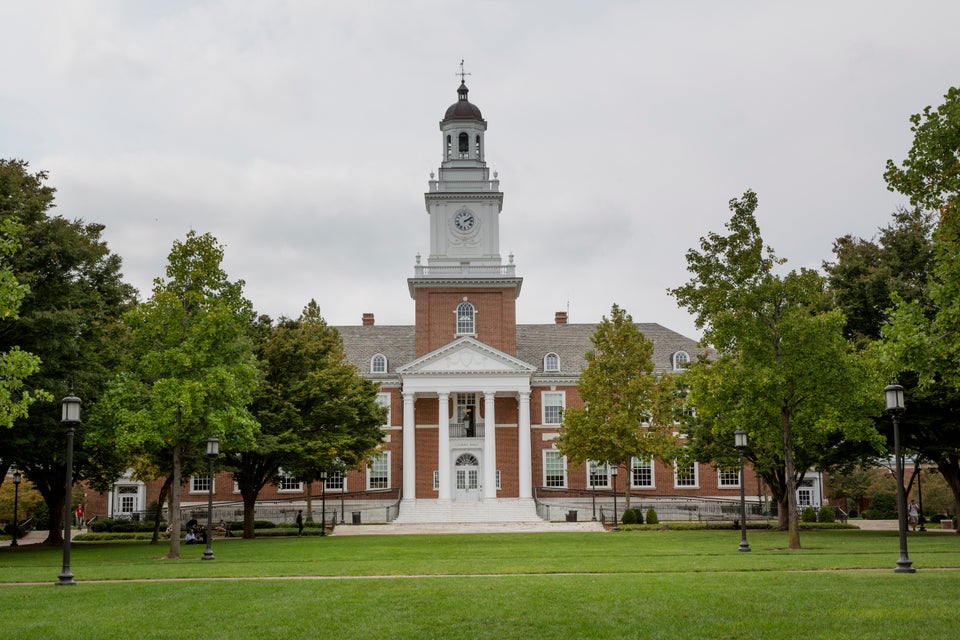
I have watched my oldest child navigate the college application vortex for the past 18 months now. As she has inched her way closer to the pearly gates of higher education, I repeatedly have asked myself, "Is this crazy or is it just me?" You decide, dear readers.
1. Higher test scores can be bought.
Pardon my total and utter shock at this realization.
When my daughter was in the 10th grade, our school gave free full-length SAT and ACT practice tests to determine which one felt the most "comfortable." The "results" of those tests were then analyzed by an expert -- who coincidentally happens to run a college advisement business that includes SAT and ACT tutoring.
Private test preparation tutoring is a big business that feeds on our collective anxiety about college. Bloomberg reports that from 1998 to 2012, the number of private test prep centers doubled to 11,000 and called it a "multi-billion dollar industry" fueled by parents willing to shell out more than $200 an hour for a tutor to teach junior "test-taking strategies."
There is no obligation, of course, to spend a fortune and have your low-scoring student be tutored. In fact, your school or local community center may run testing bootcamps and weekly evening classes for far less money. Khan Academy announced it would have free online tutoring for the newly revised SAT. But the underlying message is clear: Higher scores can be bought. How high do you want those scores to go and how deep in your wallet are you willing to dig for it?
There is a certain irony here: Of all the teaching-to-the-test that goes on in our Common Core world, how is it that the one test that nobody teaches to is the one that blocks the gateway to college?
2. "Low test scores? No problem!" Actually, yes problem.
Should your student score poorly on those preliminary SAT and ACT tests and you balk at the idea of expensive tutoring, you likely will be pointed in the direction of colleges that are "test-optional." There are about 800 schools that don't give a whit about standardized tests. Fine schools, all of them -- but a good chunk of them focus on training in art, music and culinary skills. And when you point out that your kid has no interest in art, music or learning to cook for a living, you will likely be dismissed as a delusional parent who can't accept the fact that her son's choices were just substantially narrowed because he tests poorly. The good news is that increasingly, more schools are devaluing the SAT and ACT tests in favor of other achievement markers. But don't expect to find a panacea on the test-optional list.
3. The holistic approach that isn't.
Some kids, mine included, are lousy test-takers. They are successful academically, challenge themselves with AP and honors classes, and have accomplished great things outside the classroom. They are -- or should be -- attractive candidates to colleges. Schools that take them seriously are said to be taking the holistic approach, meaning they look beyond the GPA and SAT/ACT numbers at the person who is applying.
The schools that most often go holistic are the liberal arts schools -- which incidentally are more expensive than big public schools. Big public universities like UCLA look at two numbers and two numbers only: The GPA and the SAT/ACT score. If those two numbers aren't high enough, the application is tossed. No essay is read that would explain that Sally's grades fell in sophomore year when her parents divorced or that after his dad's death, Mike needed to get an after-school job which cut into his homework time.
We all have a story. Colleges just don't always want to hear it.
4. Colleges woo kids only so that they can reject them later.
Colleges want to appear to be highly selective in who they accept. They yearn for U.S. News & World to label them as a school that is hard to get into. This is accomplished by inflating the number of students who apply so that they can reject more of them and appear to be pickier. Various tactics are used to achieve this goal. If your student so much as lands on a school's home page -- in jest, as a lark, for no good reason except they want to see if Stanford admissions have dropped to single digits -- he or she will unleash the marketing gale-force winds. The mailman will suffer back strain from all the shiny brochures he will have to deliver; student ambassadors will call the house constantly (and mostly in the middle of the school day, which suggests they don't really care about speaking to your student); there will be invites to webinars, alumni open houses, college fair booths.
And they are all just joshing with you. The don't really intend to admit your kid; his grades and test scores are way too low and everyone knows it. But by getting your student to apply, the school gets to reject one more kid and inch that selectivity rating up a notch higher. Some colleges even waive the application fee to this end.
It's pretty shameful, actually. Plus imagine how much tuition could be lowered if the marketing department just stopped this nonsense.
5. The price of college is not clearly marked.
When you go to the grocery store for milk, the price is marked on the shelf. You can decide whether you want to pay that much for it or shop somewhere else. Colleges are much less clear about pricing their products.
Liberal arts schools can top $60,000 a year for the total cost of attendance. But few actually pay the sticker price. You need to educate yourself about the Expected Family Contribution (EFC) and how to use a Net Price Calculator. And at the end of the day, your kid needs to apply and hope they are a sufficiently desirable candidate for the school to lower the price for them.
The only real way to know what college is really going to cost you is to apply and be admitted. You will get the most help from the places where your student is a strong candidate, exceeding the average GPA and scores for their typical admit. In other words, aim low and it will be cheaper.
Wouldn't it be nice if all this could be determined at the onset? This is what we charge, for real. Why inflate the price tag when few really pay that much?
6. Do you want six eggs or a half-dozen?
OK, so the small liberal arts school will cost $35,000 a year after the merit aid package, and the much larger state school will be $25,000. On the surface, you might mistakenly think the large state school is cheaper. But you would be wrong. Dig a little deeper. The liberal arts school will graduate your daughter in four years while graduation from the state school will probably take six years. Many state colleges are impacted and students can't get the classes they need to graduate in four years. The tuition and room and board for the extra time spent doing undergraduate work makes the lower-priced state school more expensive than the private one.
Plus the kids who graduate in four years get a jump on their careers, entering the job market two years sooner, moving on to second jobs and advanced positions while the state college graduate is still at the entry level.
Graduation rates and jobs placement rates six months after graduation are probably the two most ignored numbers in the college world. Ask about them before you finalize any decisions.
7. The almighty essay multiplied when you weren't looking.
Students are encouraged to start thinking about their college essay in their junior year. Find a topic that is brilliant and clever, figure out the voice you hope to convey, be original and have it read by a million people including every teacher and professional writer you know. Writing the college essay, in all its 650 glorious words, is how rising seniors are encouraged to spend their summer break. Yes, it's that important.
And then when you open up the Common App, you may learn for the first time that it's not just one essay you need because many schools actually have additional essay prompts they want you to answer. When this newsflash occurs, it will throw many into a tailspin. There will be tears, things thrown at walls and chests pounded to accompany the cries of "how did I not know this?"
It's a problem many parents throw money at -- hire someone to help -- and one of the things that catches too many people off guard. Just remember: I warned you.
8. This is the college tour that really matters and you likely won't wait for it.
The most important person at every college is not the admissions or financial aid officer. It is the student tour guide. Schools may send your son or daughter dozens of brochures, reach out to them daily by email and phone, drag out alumni who live in your city to meet them. None of it matters as much as the student tour guide.
Colleges don't seem to realize that prospective students pick up on the tour guide's vibe. The giggling sophomore guide who couldn't answer a single question but repeatedly mentioned how awesome Taco Tuesdays were left few people impressed by the school.
But there's a larger problem. College tours are a mixed bag. They give your student a snapshot of what going to school there would be like. Did you ever see a bad picture of yourself? Sometimes, college tours create bad pictures.
A far wiser way to see a campus is to attend an admitted student event. On these, your student -- after he or she has been admitted -- is invited to spend a few days and nights on campus, sit in on a few classes, sleep in the dorm. They get to actually eat the Tacos and decide their awesomeness for themselves.
But as parents, we are too nervous to wait for the admissions results. We make our college tours over spring break of their junior year, so they can "see" the schools and decide whether to apply there.
9. Picking a major and other things that really don't matter.
So much of choosing a college is focused on where your student wants to live. City or rural? Large or small campus? Close to home or as far away as they can get? Lost in the conversation is what they hope to study; what will their major be?
The reality is this: It actually may not matter. Between 50 percent and 70 percent of students change their majors at least once. Most colleges are aware of this and do their best to accommodate major-swapping. It's also why most schools have you take general education classes for the first two years before you actually dive into your selected field of study.
Still, it's good to have options. Attending a school known primarily for its engineering program may no longer be a great fit when your son wants to switch to art history. Remember, it's not where you go but where you graduate from that matters.
Also on HuffPost:

